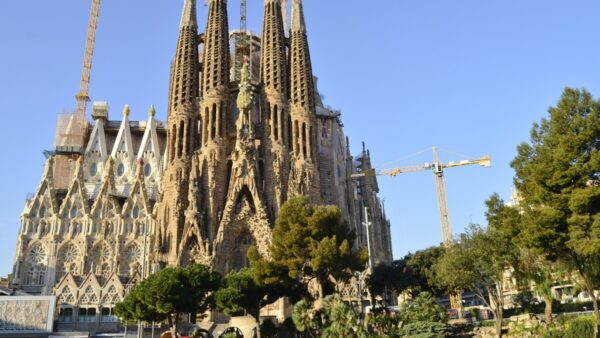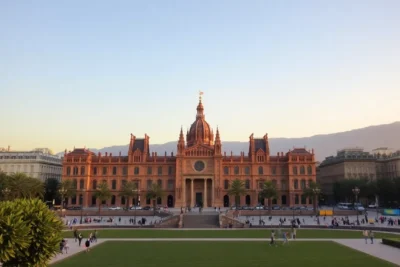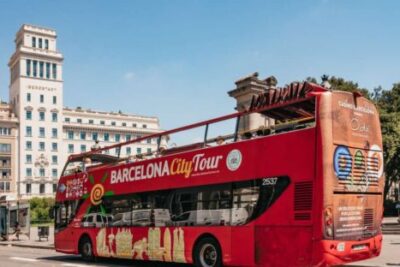
Barcelona's Sagrada Familia Church stands as an iconic symbol of architecture and devotion, captivating millions with its breathtaking design and intricate details. As one of the most recognized landmarks in the world, this basilica is not just a church; it embodies the vision of its creator, Antoni Gaudí, and the ongoing journey of its construction.
In this article, we invite you to Discover the Majestic Transformation of Barcelona's Sagrada Familia Church, exploring how this masterpiece has evolved over the years and continues to inspire awe and admiration. From its unique facades to the stunning play of light within, the Sagrada Familia reflects a living testament to creativity and faith that transcends time.
The Architectural Genius of Antoni Gaudí in Sagrada Familia
Antoni Gaudí's architectural brilliance is unmistakably showcased in the design of the Sagrada Familia, where every element serves a purpose. His approach combines natural forms with innovative engineering, resulting in a structure that is not only visually stunning but also remarkably resilient. Gaudí's distinctive style incorporates geometric shapes, organic motifs, and vibrant colors, harmonizing with the surrounding landscape and enhancing the spiritual atmosphere of the basilica.
One of the most remarkable aspects of Gaudí's work is his ability to integrate light into the architecture. The Sagrada Familia features strategically placed stained glass windows that create a mesmerizing play of colors inside the church. This immersive experience can be observed through:
- Translucent glass that filters sunlight, casting rainbow hues on the walls.
- Large, colorful rose windows that act as focal points within the sacred space.
- Illuminated columns that mimic tree trunks, enhancing the naturalistic theme.
Moreover, Gaudí's dedication to sustainability is evident in his use of local materials and techniques. His commitment to preserving the environment is a reflection of his deep spiritual beliefs. The innovative use of structural solutions, such as catenary arches and hyperboloid surfaces, showcases his visionary approach to engineering, allowing for the basilica's towering spires while maintaining stability.
Finally, the ongoing construction of the Sagrada Familia exemplifies the collaboration across generations. Since Gaudí's passing in 1926, architects and craftsmen worldwide have continued his legacy, utilizing modern technology while respecting his original vision. This harmonious blend of tradition and innovation not only preserves Gaudí's genius but also ensures the basilica remains a symbol of hope and faith for years to come.
The Ongoing Construction of Barcelona’s Sagrada Familia: A Historical Overview
The ongoing construction of Barcelona’s Sagrada Familia is a remarkable journey that spans over a century. Initiated in 1882, this monumental basilica is a blend of historical dedication and modern ingenuity. The project has faced numerous challenges, including financial constraints and the impacts of the Spanish Civil War, which delayed progress significantly. Yet, the passion for Gaudí’s vision has kept the project alive, inspiring both locals and visitors alike.
As of now, the construction is estimated to be around 70% complete, with a projected completion date of around 2026, coinciding with the centenary of Gaudí’s death. The construction timeline can be summarized in key phases:
- 1882-1926: Foundation and initial structure developed under Gaudí's supervision.
- 1926-1950s: Work halted during the Spanish Civil War, leading to a gap in construction.
- 1960s-present: Restoration of Gaudí's original plans and adaptation of modern technology.
Throughout the years, various architects have taken up the mantle to ensure the fidelity of Gaudí’s design while integrating contemporary techniques. This collaborative effort emphasizes the importance of preserving the original vision while adapting to modern building practices. The use of advanced tools, such as computer-aided design, has helped in accurately interpreting Gaudí’s complex geometries and intricate details.
Ultimately, the ongoing construction of the Sagrada Familia is more than just a building project; it is a testament to the enduring spirit of creativity and faith. Each completed section serves as a reminder of the shared dedication to honoring Gaudí’s monumental legacy and the collective aspiration for a symbol of hope that transcends generations.
Unveiling the Symbolism of the Sagrada Familia's Intricate Facades
The facades of the Sagrada Familia are a rich tapestry of symbolism, each telling a unique story that reflects the profound spirituality of Gaudí’s vision. The Nativity Facade, for instance, celebrates the birth of Christ through its intricate detailing, showcasing figures and scenes that highlight themes of love, joy, and nature's beauty. In contrast, the Passion Facade evokes a sense of solemnity and sacrifice, emphasizing the suffering of Jesus with stark lines and evocative sculptures.
Key symbolic elements within the facades include:
- Natural motifs: Inspired by the flora and fauna, these designs represent the connection between God and creation.
- Religious figures: Statues of saints and biblical characters narrate pivotal moments in Christian theology.
- Light and shadow: The interplay of light through the structures reflects divine presence, changing throughout the day to enhance spiritual experience.
Additionally, Gaudí incorporated architectural styles from various periods, merging Gothic and Art Nouveau elements to create a distinctive visual language. This fusion serves as a metaphor for the unity of different faiths and cultures, reinforcing the Sagrada Familia as a universal symbol. The dynamic forms of the facades invite contemplation, encouraging visitors to reflect on the deeper meanings behind each sculptural detail.
To further understand the significance of the Sagrada Familia's facades, consider the following comparisons:
| Facade | Symbolism | Architectural Style |
|---|---|---|
| Nativity Facade | Celebration of life and joy | Gothic and Art Nouveau |
| Passion Facade | Reflection of suffering and sacrifice | Expressionist and modernist influences |
Ultimately, the intricate facades of the Sagrada Familia are not merely decorative; they are profound narratives that encapsulate Gaudí's belief in a divine connection between artistry and faith. Each element invites visitors to engage with the spiritual journey of the church, making the Sagrada Familia a true masterpiece of religious architecture.
A Closer Look at the Stunning Interior Design of Sagrada Familia Church
The interior design of Sagrada Familia Church is as breathtaking as its exterior, featuring a harmonious blend of natural elements and spiritual symbolism. Upon entering, visitors are immediately struck by the majestic columns, which resemble tree trunks, creating the sensation of being inside a forest. These columnar structures support the basilica’s ceiling while also enhancing the organic feel that Gaudí envisioned for this sacred space.
The play of light within the interior is another captivating aspect. The stained glass windows not only provide color but also tell stories from the Bible, bathing the interior in a variety of hues throughout the day. This transformation is achieved through:
- Delicate patterns that filter sunlight into vibrant mosaics.
- Strategic placement of windows to maximize the spiritual impact of light.
- Color gradients that transition from cool blues to warm reds, representing different aspects of the divine.
Moreover, the ceiling design showcases intricate geometrical shapes that echo the natural world. Gaudí employed hyperboloid forms to create a sense of movement and dynamism, resembling the undulating lines of nature. This design not only serves aesthetic purposes but also aids in acoustics, enhancing the auditory experience during services and events.
Lastly, the interior space serves as a focal point for spiritual gatherings and community events, reinforcing the church's role as a living entity. The combination of architectural innovation, visual storytelling, and communal spirit makes the interior of Sagrada Familia a truly unique experience, inviting visitors to reflect on their own spiritual journeys within this architectonic wonder.
The Cultural Significance of Sagrada Familia in Modern Barcelona
The Sagrada Familia holds immense cultural significance in modern Barcelona, functioning as a beacon of creativity and spirituality that resonates with both locals and international visitors. This architectural masterpiece is not only a representation of Gaudí's visionary genius but also a symbol of the city's identity, embodying the rich tapestry of Catalan culture. It serves as a place where art, faith, and community converge, fostering a sense of belonging and pride among the people of Barcelona.
Moreover, the basilica has become a central hub for cultural events, religious ceremonies, and artistic expressions. Its ongoing construction invites participation from a diverse array of artists, architects, and volunteers, promoting a shared mission that transcends boundaries. The Sagrada Familia's evolution reflects the city's dynamic spirit, adapting to contemporary values while remaining rooted in its historical significance. This adaptability plays a key role in its relevance to modern society.
As a UNESCO World Heritage Site, the Sagrada Familia is recognized not only for its architectural brilliance but also for its contribution to the global cultural landscape. This recognition has enhanced its status as an international symbol of faith and creativity, attracting millions of visitors each year. The basilica's intricate designs and profound storytelling through architecture continue to captivate audiences, emphasizing the importance of preserving cultural heritage in an ever-changing world.
Finally, the Sagrada Familia stands as a testament to Barcelona's resilience and dedication to visionary art. Its construction, spanning over a century, symbolizes the collective effort of generations striving to realize Gaudí's dream. This enduring project inspires future artists and architects to push boundaries, proving that creativity can flourish even amidst challenges. The Sagrada Familia is more than a monument; it is a living entity that evolves alongside the city, embodying the heart and soul of Barcelona.
Visiting Sagrada Familia: Tips for an Unforgettable Experience
Visiting the Sagrada Familia is a once-in-a-lifetime experience, and planning your trip wisely can enhance your enjoyment. To make the most of your visit, consider these helpful tips:
- Book your tickets in advance: Purchase your tickets online to avoid long queues and ensure a smooth entry.
- Visit during off-peak hours: Early mornings or late afternoons are ideal times to avoid crowds.
- Consider a guided tour: A knowledgeable guide can provide fascinating insights into Gaudí's architectural innovations and the basilica's rich history.
When exploring the Sagrada Familia, take time to appreciate the intricate details both inside and out. Make sure to:
- Explore the Nativity and Passion Facades: Each facade tells a different part of Christ's story, showcasing Gaudí's unique interpretation of religious themes.
- Admire the interior: The stunning stained glass windows create a vibrant atmosphere, particularly during sunlight hours, which further enhance the spiritual experience.
Also, be sure to pause and soak in the surroundings. The areas around the Sagrada Familia offer picturesque views and peaceful spots for reflection. Don't forget to:
- Visit the park nearby: The park provides a quiet retreat from the hustle and bustle, with excellent vantage points for photography.
- Enjoy local cuisine: Sample traditional Catalan dishes at nearby cafes for a complete cultural experience.
Finally, remember that the Sagrada Familia is still under construction, a testament to its enduring legacy. Keep an open mind as you witness this architectural marvel evolve, and take the opportunity to reflect on the cultural significance it holds for both Barcelona and the world.
 Sagrada Familia Barcelona Store: Un paraíso de recuerdos y souvenirs
Sagrada Familia Barcelona Store: Un paraíso de recuerdos y souvenirs Sagrada Familia Barca Store: A Must-Visit for FC Barcelona Fans
Sagrada Familia Barca Store: A Must-Visit for FC Barcelona FansIf you want to know other articles similar to Discover the Majestic Transformation of Barcelona's Sagrada Familia Church you can visit the category Blog.
Leave a Reply










Read more!